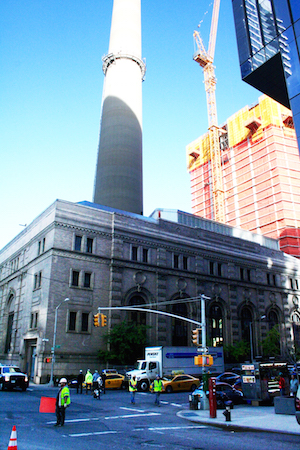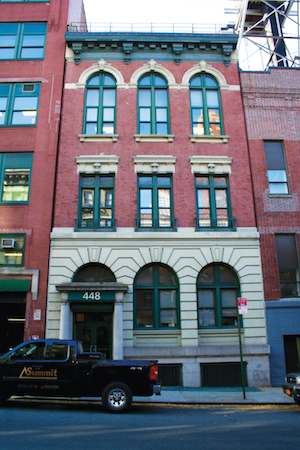BY YANNIC RACK | The battle between preservationists and Con Edison is heating up in Hell’s Kitchen, as both parties fight over the future of a historic power station that once fueled the city’s first subway line.

Jumping at their last chance to landmark the former Interborough Rapid Transit Powerhouse on 11th Ave., preservation groups and local residents recently made passionate pleas to the Landmarks Preservation Commission (LPC).
“Let’s landmark it already,” said Brian Webber, to laughter and applause from many who packed the commission’s meeting room for a special hearing on Nov. 5.
“LPC exists to save buildings such as this one. So please do it.”
“This is an important building,” said Alyssa Bishop, who founded the Hudson River Powerhouse Group in 2007 to push for the station’s landmarking.
“There’s development directly across the street to the south, there’s development to the north, there’s a massive restoration to the east. It’s only a matter of time before this building becomes more valuable than it is right now,” she added.
Over two dozen residents and organizations gave similar testimony at the hearing, one of a handful that were set up to specifically address the commission’s backlog of 95 buildings throughout the city.
Stretching for a whole block between W. 58th and W. 59th Sts., the Beaux-Arts style powerhouse is one of the more ancient additions to the list. It has been in landmarking limbo for over 35 years — the first time it was considered for designation at a public hearing of the commission was in 1979.
Since then, the commission has considered the building in 1990 and 2009, but both times decided to delay designation because of opposition from Con Ed, which has owned and operated the station since the 1950s.
“The commission is not doing what they’ve been mandated to do,” said Arlene Simon, founder and former president of Landmark West!, a preservation group based on the Upper West Side.
“They are not potted plants, even though they think they’re potted plants,” she said of the commissioners.
Two representatives from Con Ed were also at the hearing to testify against the building’s designation.
The 59th St. plant is currently used as part of the company’s steam system, serving around 1,800 customers in Manhattan — including some of the city’s most recognizable landmarks, like the Empire State Building and Grand Central Terminal, according to a spokesperson.
“Our 59th Street steam plant is a living and breathing monument to adaptive reuse,” said Gus Sanoulis, Con Ed’s Vice President for Steam Operations, at the hearing.
He said Con Ed had just recently invested over $150 million to upgrade the station, and argued that the restrictions that come with landmarks designation are not consistent with operating an active power plant.
“We need the flexibility to make changes to the plant’s interior and exterior that enables the cleanest, most efficient, and reliable production of energy,” he said.
“Power generating plants are not like other typical landmarked buildings,” added Edward Conway, the plant manager at the station. “Operations and equipment size are much different — sometimes equipment can only be replaced by removing a wall.”
But their opponents point out that Con Ed has operated under restrictions for years, while the building remained on the landmarks calendar — and the Con Ed reps even emphasized themselves that the company has previously worked with the landmarks commission, such as when it replaced several windows with ventilation louvers in order to comply with state safety regulations.
“Clearly, over the 36 years that they have asked for a delay in designation, they have been able to work under the restrictions of the landmarks commission,” said Anne Weisberg, who represented her local condominium board at the hearing.
“So my feeling is, if we take the power plant off [the LPC calendar], then they will have no restrictions and we will lose any ability to keep the character of the plant.”
Preservationists similarly say that the risk of leaving the building’s future up to Con Ed is too risky.
“Con Edison doesn’t want it to be landmarked, because could you imagine how much money they could get?” said Simon, of Landmark West!
“They’re prepared to tear this building down. There are 13 buildings going up along 59th Street and this will be one more.”
Some details of the building, like cornices and roof tiles, have already been removed over time, and Con Ed has also taken down all of the station’s six original smokestacks, or chimneys, which were “designed to echo those of ocean liners on the nearby Hudson River,” according to a 1997 New York Times article (one newer chimney remains at the southeast corner of the building).
When it was built in 1904, the building was the largest power station in the world, feeding a total of eight substations to power the signal and lighting systems of the Interborough Rapid Transit (IRT) subway — the city’s first underground transit system.
The powerhouse is “the most monumental building associated with the subway system in New York City,” notes the LPC’s hearing statement from 2009.
It was designed by Stanford White of the prominent architectural firm McKim, Mead & White, which is responsible for a host of other New York City institutions, including the former Pennsylvania Station, the Brooklyn Museum, and the main campus of Columbia University.
Even White’s great-grandson, Samuel White, himself an architect and author of three books on the firm, offered his testimony on the building.
“Three public hearings have established that the building meets all criteria for designation. It is significant for historical, cultural, technological, and architectural reasons,” he wrote in a recent letter to the commission that was read at the hearing.
“The record is robust and the time for action is now.”

In the spring, the commission will either vote to expedite landmarking of the building (in which case it would be designated within the year), drop it from the calendar by issuing a no-action letter, or vote not to designate it.
The powerhouse wasn’t the only potential landmark in the area that was discussed at the hearing — the Mission of the Immaculate Virgin West, a three-story building on W. 56th St., was also on the table.
Built in 1903 for the Mission of the Immaculate Virgin, a catholic charity, the Beaux-Arts style building has housed part of the nearby High School for Environmental Studies since the mid-1990s.
Although Community Board 4 (CB4) supports its designation, it barely received any attention at the hearing, and one audience member even argued that it should be dropped from the calendar, having “no special character or historic significance” at all.
The testimony stood in stark contrast to the letters and statements submitted on behalf of landmarking the IRT Powerhouse — not just from preservationists, but also CB4 and local officials, including Councilmember Helen Rosenthal and Manhattan Borough President Gale Brewer.
But the most earnest appeals at the hearing came from local residents, who feel the powerhouse stands out in a neighborhood that is being rapidly transformed by new construction.
“There’s tremendous development all around the power plant…there are all these glassy new buildings. It creates an anchor in the neighborhood to all that development that’s going on,” said Weisberg, who lives one block away from the site on West End Ave.
“The power plant is literally the only testament in our neighborhood to its past.”




































